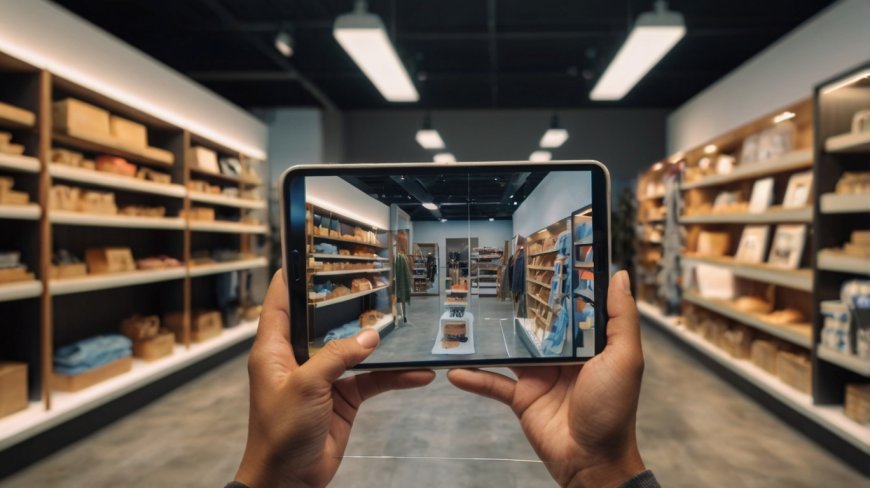Augmented Reality (AR) in E-Commerce: Revolutionizing Shopping
Discover how AR is transforming online shopping experiences by enhancing customer engagement and personalization.

Augmented Reality (AR) in E-Commerce: Revolutionizing Shopping
Augmented Reality (AR) is rapidly transforming the e-commerce landscape by bridging the gap between online and in-store shopping experiences. By overlaying digital content onto the real world, AR allows customers to visualize products in their environment, try on items virtually, and make more informed purchasing decisions. As e-commerce continues to evolve, AR is becoming a critical tool for enhancing customer engagement, reducing returns, and boosting sales.
This blog explores the role of AR in e-commerce, its benefits, challenges, real-world applications, and future trends.
What is Augmented Reality in E-Commerce?
AR in e-commerce refers to the integration of augmented reality technology into online shopping platforms. AR enables users to interact with virtual representations of products in real-time, providing a more immersive and personalized shopping experience.
Key Features of AR in E-Commerce:
-
Product Visualization: View products in 3D and place them in real-world settings.
-
Virtual Try-Ons: Try on clothing, accessories, or makeup using AR-powered apps.
-
Interactive Product Demos: Explore the features and functionalities of products through AR experiences.
-
Enhanced Product Customization: Modify product features in real-time to match preferences.
Benefits of AR in E-Commerce
-
Improved Customer Experience
-
AR creates engaging and interactive shopping experiences, helping customers better understand products.
-
-
Reduced Returns
-
Visualizing products in real-world contexts minimizes the mismatch between expectations and reality, leading to fewer returns.
-
-
Increased Conversion Rates
-
AR tools provide customers with confidence in their purchase decisions, driving higher conversion rates.
-
-
Personalization
-
AR enables tailored shopping experiences, allowing customers to customize products and visualize them in real-time.
-
-
Competitive Advantage
-
Businesses adopting AR stand out in a crowded e-commerce market, attracting tech-savvy customers.
-
-
Higher Customer Engagement
-
Interactive AR experiences keep customers engaged longer, increasing the likelihood of purchase.
-
Applications of AR in E-Commerce
-
Home Furnishing and Decor
-
AR allows customers to visualize furniture and decor items in their homes before purchasing.
-
Example: IKEA Place app lets users place virtual furniture in their rooms to see how it fits and looks.
-
-
Fashion and Apparel
-
Virtual try-on features enable customers to see how clothes, shoes, or accessories look on them.
-
Example: Gucci’s AR app lets customers try on sneakers virtually.
-
-
Beauty and Cosmetics
-
AR-powered apps let users test makeup products like lipstick, eyeshadow, or foundation on their faces.
-
Example: L’Oréal’s Modiface provides virtual makeup try-ons.
-
-
Electronics and Appliances
-
AR demos showcase product features, helping customers understand functionality and dimensions.
-
Example: Samsung’s AR viewer helps customers visualize TVs and appliances in their spaces.
-
-
Automotive
-
AR enables customers to explore vehicle interiors and exteriors in 3D and customize features.
-
Example: BMW’s AR app allows users to visualize and configure cars in their driveways.
-
-
Jewelry and Accessories
-
AR try-ons help customers see how jewelry and watches look on them without visiting a store.
-
Example: Blue Nile’s AR tool lets users virtually try on engagement rings.
-
Challenges of AR in E-Commerce
-
High Development Costs
-
Creating AR tools and experiences requires significant investment in technology and expertise.
-
Solution: Start with scalable AR solutions and prioritize high-impact products.
-
-
Device Compatibility
-
AR experiences may not work seamlessly across all devices and platforms.
-
Solution: Optimize AR tools for popular devices and browsers.
-
-
Customer Adoption
-
Some customers may be unfamiliar with AR or hesitant to use it.
-
Solution: Provide clear instructions and user-friendly interfaces to encourage adoption.
-
-
Data Privacy Concerns
-
Collecting user data for AR experiences raises privacy and security issues.
-
Solution: Implement robust data protection measures and comply with regulations like GDPR.
-
-
Technical Challenges
-
Ensuring smooth and realistic AR experiences requires advanced technology and infrastructure.
-
Solution: Partner with AR technology providers to leverage their expertise.
-
Future Trends in AR for E-Commerce
-
AI Integration
-
Combining AR with artificial intelligence will enhance personalization and recommendation systems.
-
-
WebAR
-
Browser-based AR experiences will eliminate the need for app downloads, increasing accessibility.
-
-
5G-Powered AR
-
Faster internet speeds will enable more immersive and real-time AR experiences.
-
-
Social Commerce
-
AR features integrated into social media platforms will drive e-commerce sales directly through apps like Instagram and Snapchat.
-
-
AR Shopping in the Metaverse
-
Virtual worlds will enable customers to shop in immersive 3D environments using AR and VR technologies.
-
Best Practices for Implementing AR in E-Commerce
-
Focus on User Experience
-
Design AR tools that are intuitive, engaging, and easy to use.
-
-
Provide Value
-
Ensure AR experiences address customer pain points, such as difficulty visualizing products.
-
-
Test Across Devices
-
Optimize AR solutions for compatibility with various devices and platforms.
-
-
Educate Customers
-
Offer tutorials or demos to help customers understand how to use AR features effectively.
-
-
Measure Performance
-
Track metrics like engagement, conversion rates, and return rates to evaluate the effectiveness of AR tools.
-
Conclusion
Augmented Reality is revolutionizing the e-commerce industry by creating immersive, interactive, and personalized shopping experiences. From virtual try-ons to 3D product visualization, AR empowers customers to make confident purchasing decisions while enabling businesses to stand out in a competitive market.
As technology advances and adoption grows, AR will continue to shape the future of e-commerce, bridging the gap between digital and physical shopping experiences. Businesses that invest in AR today will be well-positioned to lead the industry tomorrow.

 datawaves
datawaves 





